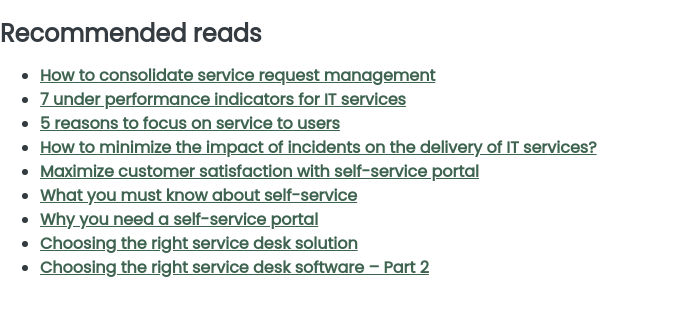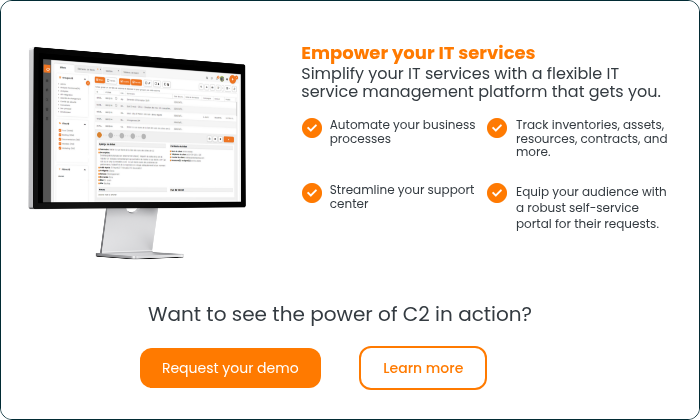Those actions might sound vague described that way because they’re not tied to any specific product or process. That is by design. Service desks are highly flexible models. If you can package a business function as a service, a service desk can help you plan, deliver, and maintain that service as effectively as possible.
Service desks are commonly used for managing IT services, but service desk models are used increasingly for other enterprise service functions. The business model is called enterprise service management (ESM) in those cases. For example, delivering business services in finance departments (cost control and budget management, financial reporting and analytics and compliance and risk management), human resources (onboarding and offboarding, performance evaluation and training and satisfaction and engagement), or facilities.
As the single point of contact, service desks are also typically responsible for building documentation and knowledge bases for service staff and users. Service desk staff are best positioned to do this because of the high volume of interactions they have regarding essential business services. They will typical
What is a Help Desk?
A help desk is a point of contact for resolving IT issues within an organization. It offers a great deal of value, but it’s much narrower in scope than service desks.
Unlike a service desk, it may not be the only point of contact, but one of many for specific issues. Typically help desks are the point of contact for resolving one-off technical issues or break/fix problems. For example, crashing desktop software, a tablet that won’t power on, or network outages.
In the language of ITSM—more on that below—help desks are responsible for incident management. Unlike service desks, which are more comprehensive and support proactive work, help desks are generally reactive. They handle incident response when something goes wrong to restore service as quickly as possible.
What is IT Service Management (ITSM)?
IT service management is a range of business practices for planning, delivering, and maintaining information technology in the form of services. Services are a solution to a business need or problem, not a specific product. For example, under ITSM, you might request to onboard a new employee instead of procuring a laptop.
That difference might sound trivial, but packaging information technology as a service drastically changes how an organization thinks about and structures its operations. It creates more consistency by standardizing services and makes work more measurable.
Choosing the Right Approach: When to Opt for ITSM, Service Desk, or Help Desk
Help desks can exist independently without any wider structure or methodology in place. On the other hand, service desks are typically deployed as part of an ITSM business model. They’re not just a tool for a tech support team. They’re integrated with wider IT and business practices.
DevOps, engineers, human resources, finance, and other units structure their business practices to align with the wider ITSM model facilitated by the service desk. That allows a service desk to facilitate much more complex tasks than a help desk. For example, service desks are typically set up to handle all ITSM practices, including:
- Request Management
- Asset Management
- Incident Management
- Problem Management
- Change Management
- Knowledge Management
Help desks focus on incident management
As mentioned above, help desk models tend to be more reactive and focused on resolving specific, immediate technical problems. Since that is their focus, help desk ticketing software tends to be narrow in scope and designed to facilitate reactive problem-solving.
Emerging Trends in ITSM and Service Desk Technologies
On the other hand, service desk software ensures those wider ITSM practices are carried out smoothly, enabling more progressive IT and business actions. For example, change management processes enabled by a service desk will ensure upgrades and rollouts happen reliably and efficiently.
Why Implement ITSM, Service Desk, and Help Desk Solutions?
Now you better understand service desk vs. help desk vs. ITSM. Should you stick with the basic help desk setup you have now?
Expanding from a help desk setup to a full-fledged ITSM service desk takes some planning, but it is well worth the effort. Service desks within ITSM methodologies offer a few key advantages.
Robust self-service options
Service desk software can deploy self-service portals so users can access knowledge base articles, FAQs, and self-service utilities to get what they need faster. For example, self-service password reset apps are a common tool that service desk software can automate so agents remain free to handle more complex tasks.
Centralized efficiency
Service desks bring together functions from throughout your organization onto one single platform. Project managers can collaborate with engineers, engineers with service technicians, financial officers, physical plant managers, and anyone else involved in the complex work of delivering information services to your customers. It is all tracked in central software, so you get better end-to-end monitoring capabilities and reporting on complex processes.
Enhanced collaboration
ITSM methodologies structure the relationship between providers and customers. Those customers can be external to your organization, but they can also be internal. For example, your sales manager could submit a service request to provision IT resources for a new user. That could kick off a series of sub-requests, including account provisioning requests to IT and human resources and a new laptop provisioning request to the endpoint team.
That network of requests touches several different teams. They need to collaborate to ensure their actions are aligned. Service desk software supports far-reaching and integrated workflows such as these new user provisioning requests.
Better insights
Service desks can generate more and better insights by centralizing management of the various service actions within your organization. Centralization allows you to collect data at every touch point. As a result, you’ll be able to identify trends you might not have identified otherwise.
The Right Service Desk Can Drive Your Business Forward
Service desk vs. help desk vs. ITSM—each has a role. A great ITSM platform can ensure your service desk and help desk run as smoothly and efficiently as possible. C2 ITSM helps businesses manage workflows, enhance IT capabilities, and foster productivity.








